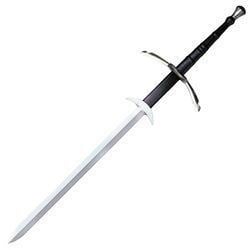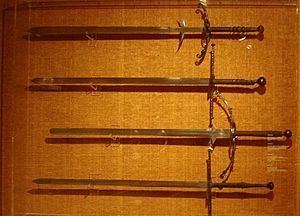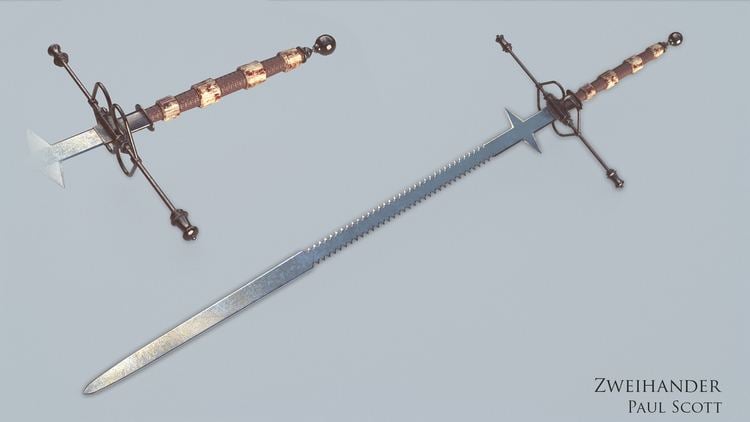In service ca. 1500-1550 | ||
 | ||
Blade type Double-edged, straight bladed Hilt type Two-handed cruciform, with pommel Weight 2–3.2 kilograms (4.4–7.1 lb) Length up to 180 centimetres (5.9 ft) | ||
Seminar zweih ndertag 2016 by drey wunder montante great sword and zweih nder
The Zweihänder ( [-]) (a non-historical modern popular term, German term for "two hander", for the more accurate Doppelhänder ("double-hander") or Beidhänder ("both-hander")) is a type of large two-handed sword primarily in use during the early decades of the 16th century.
Contents
- Seminar zweih ndertag 2016 by drey wunder montante great sword and zweih nder
- Morphology
- Application
- References

The Zweihänder swords develop from the bastard sword or montante of the Late Middle Ages and they became a hallmark weapon of the German Landsknechte from the time of Maximilian I (d. 1519) and during the Italian Wars of 1494–1559. The Goliath Fechtbuch (1510) shows an intermediate form between longsword and Zweihänder.

These swords represent the final stage in the trend of increasing size that started in the 14th century. In its developed form, the Zweihänder has acquired the characteristics of a polearm rather than a sword. Consequently, it is not carried in a sheath but across the shoulder like a halberd.

By the second half of the 16th century, these swords had largely ceased to have a practical application, but they continued to see ceremonial or representative use well into the 17th century. Some ceremonial zweihänder, called "bearing-swords" or "parade-swords" (Paradeschwert) were much larger and weighed about 10 pounds (4.5 kg).

Morphology

Due to their size and weight—typically at least 1.4 m (4 ft 7 1⁄8 in) long and with a weight of over 2 kg—Zweihänders require two hands, as such they require at least 25 cm (9.84 in) for the grip. Zweihänders above 4 kg are considered to be more ceremonial than practical.
Early Zweihänders were simply larger versions of longswords. Later examples had Parierhaken ("parrying hooks") at the top of the ricasso as well as side rings on the hilt. A sword did not necessarily have both features. Some Zweihänders had wavy blades and were called Flammenschwert.
Application
The weapon is mostly associated with either Swiss or German mercenaries known as Landsknecht, and their wielders were Doppelsöldner. However, the Swiss outlawed their use, while the Landsknechte kept using them until much later. The Black Band of German mercenaries (active during the 1510s and 1520s) included 2,000 two-handed swordsmen in a total strength of 17,000 men. Zweihänder-wielders fought with and against pike formations. Soldiers trained in the use of the sword were granted the title of Meister des langen Schwertes (lit. Master of the Long Sword) by the Marx brotherhood.
Frisian hero Pier Gerlofs Donia is reputed to have wielded a Zweihänder with such skill, strength and efficiency that he managed to behead several people with it in a single blow. The Zweihänder ascribed to him is, as of 2008, on display in the Fries Museum. It has a length of 213 cm (84 in) and a weight of about 6.6 kg (14 1⁄2 lb).
